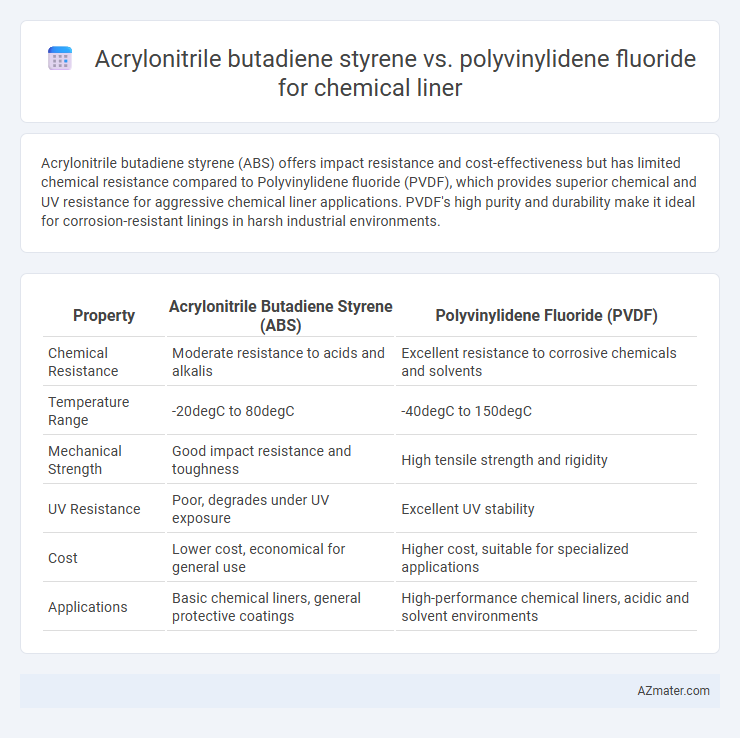Acrylonitrile butadiene styrene (ABS) offers impact resistance and cost-effectiveness but has limited chemical resistance compared to Polyvinylidene fluoride (PVDF), which provides superior chemical and UV resistance for aggressive chemical liner applications. PVDF's high purity and durability make it ideal for corrosion-resistant linings in harsh industrial environments.
Table of Comparison
| Property | Acrylonitrile Butadiene Styrene (ABS) | Polyvinylidene Fluoride (PVDF) |
|---|---|---|
| Chemical Resistance | Moderate resistance to acids and alkalis | Excellent resistance to corrosive chemicals and solvents |
| Temperature Range | -20degC to 80degC | -40degC to 150degC |
| Mechanical Strength | Good impact resistance and toughness | High tensile strength and rigidity |
| UV Resistance | Poor, degrades under UV exposure | Excellent UV stability |
| Cost | Lower cost, economical for general use | Higher cost, suitable for specialized applications |
| Applications | Basic chemical liners, general protective coatings | High-performance chemical liners, acidic and solvent environments |
Introduction to Chemical Liners
Chemical liners protect equipment from corrosion and chemical damage in industrial environments by providing a barrier resistant to aggressive substances. Acrylonitrile butadiene styrene (ABS) offers impact resistance and moderate chemical stability, ideal for general-purpose lining applications under less aggressive chemical exposure. Polyvinylidene fluoride (PVDF) exhibits superior chemical resistance, including against strong acids and solvents, making it suitable for highly corrosive environments demanding long-term durability and minimal degradation.
Overview of Acrylonitrile Butadiene Styrene (ABS)
Acrylonitrile Butadiene Styrene (ABS) is a thermoplastic polymer known for its high impact resistance, toughness, and chemical stability, making it a popular choice for chemical liners in industrial applications. Its molecular structure combines acrylonitrile's chemical resistance, butadiene's toughness, and styrene's rigidity, providing a balanced performance in corrosive environments. ABS offers cost-effective fabrication and excellent mechanical properties, though it generally exhibits lower chemical resistance compared to Polyvinylidene Fluoride (PVDF).
Overview of Polyvinylidene Fluoride (PVDF)
Polyvinylidene fluoride (PVDF) is a high-performance fluoropolymer known for its exceptional chemical resistance, thermal stability, and mechanical strength, making it ideal for chemical liner applications. PVDF offers superior resistance to acids, bases, and solvents, outperforming acrylonitrile butadiene styrene (ABS) in harsh chemical environments and high-temperature conditions. Its low permeability and excellent durability ensure long service life and reliable containment of aggressive chemicals in industrial systems.
Chemical Resistance: ABS vs PVDF
Polyvinylidene fluoride (PVDF) outperforms Acrylonitrile Butadiene Styrene (ABS) in chemical resistance, making it highly suitable for aggressive chemical liner applications. PVDF exhibits exceptional resistance to acids, bases, and organic solvents, whereas ABS tends to degrade or swell when exposed to strong chemicals. The superior chemical inertness of PVDF ensures longer service life and reliability in harsh chemical environments compared to ABS.
Mechanical Properties Comparison
Acrylonitrile butadiene styrene (ABS) offers high impact resistance and good tensile strength, making it suitable for chemical liners requiring durability under mechanical stress. Polyvinylidene fluoride (PVDF) exhibits superior chemical resistance and maintains mechanical integrity at elevated temperatures, with notable hardness and tensile strength that surpass ABS in harsh chemical environments. While ABS provides flexibility and impact toughness, PVDF is preferred for chemical liners in applications demanding enhanced mechanical strength and thermal stability.
Thermal Stability and Performance
Acrylonitrile butadiene styrene (ABS) offers moderate thermal stability with a melting point around 105degC, making it suitable for applications with mild temperature exposure but less ideal for high-heat chemical liners. Polyvinylidene fluoride (PVDF) exhibits superior thermal stability, maintaining performance at temperatures up to 150degC or higher, which ensures better resistance to heat-induced degradation in aggressive chemical environments. PVDF's enhanced thermal durability and chemical resistance make it the preferred choice for high-performance chemical liners requiring long-term stability and reliability under thermal stress.
Cost Analysis and Economic Considerations
Acrylonitrile butadiene styrene (ABS) offers a lower initial cost compared to Polyvinylidene fluoride (PVDF), making it a more budget-friendly option for chemical liners in applications with moderate chemical exposure. PVDF, while more expensive upfront, provides superior chemical resistance, durability, and longer service life, which may translate to lower maintenance and replacement costs over time. Economic considerations should weigh the total cost of ownership, including installation, maintenance, and lifespan, where PVDF often proves more cost-effective for highly corrosive environments despite its higher initial investment.
Installation and Fabrication Differences
Acrylonitrile butadiene styrene (ABS) offers easier installation and fabrication due to its greater thermal weldability and flexibility, allowing for faster joint sealing and reduced downtime. Polyvinylidene fluoride (PVDF) requires more specialized welding techniques and higher temperatures, demanding skilled labor and extended cooling periods that impact installation schedules. ABS's lower density and cost-efficient processing make it preferable for large-scale chemical liner applications, whereas PVDF excels in high-corrosion environments but with more complex fabrication requirements.
Applications in Chemical Lining Environments
Acrylonitrile butadiene styrene (ABS) offers excellent chemical resistance to organic solvents and alkalis, making it suitable for lining tanks and pipes handling non-corrosive chemicals in industrial settings. Polyvinylidene fluoride (PVDF) provides superior resistance to a broader range of aggressive chemicals, including strong acids and oxidizers, making it ideal for highly corrosive chemical lining environments such as chemical processing plants and acid storage tanks. The choice between ABS and PVDF depends on the specific chemical exposure and temperature conditions, with PVDF favored for harsh, high-temperature applications requiring enhanced durability and chemical stability.
Choosing the Right Material: ABS or PVDF
When selecting a chemical liner, Polyvinylidene fluoride (PVDF) offers superior chemical resistance and durability compared to Acrylonitrile Butadiene Styrene (ABS), making it ideal for aggressive chemical environments. ABS is more cost-effective and provides good mechanical strength and impact resistance but lacks the long-term chemical stability of PVDF. Consider PVDF for applications requiring high purity and resistance to solvents, while ABS suits budget-conscious projects with moderate chemical exposure.

Infographic: Acrylonitrile butadiene styrene vs Polyvinylidene fluoride for Chemical Liner
 azmater.com
azmater.com